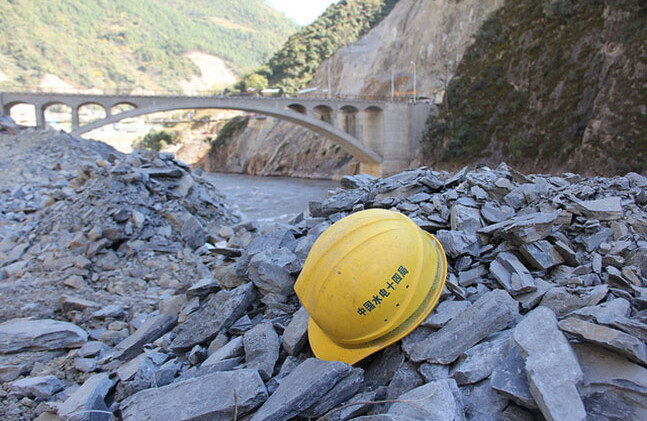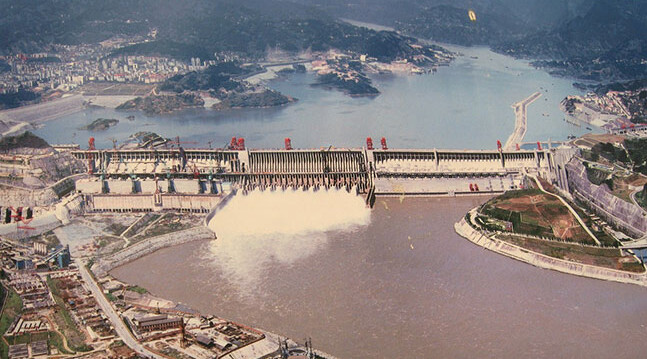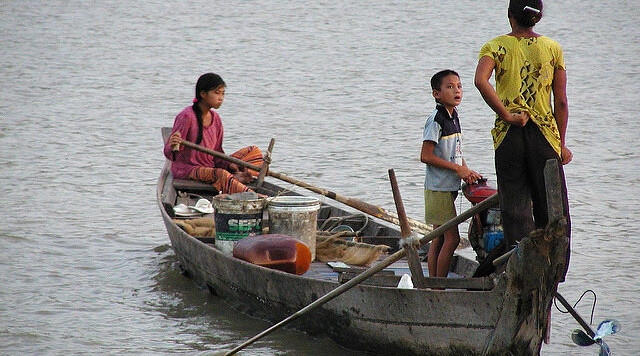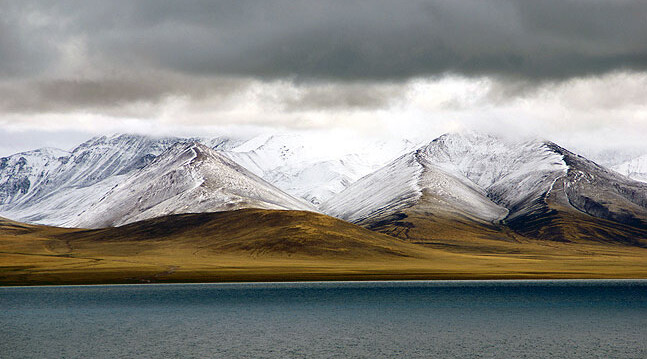Tibet, known as "the roof of the world," is seen as a place of peace and tranquility where humans and nature may co-exist in harmony. For Tibetans, the hills, mountains, and rivers are regarded as sacred places to be left in their natural state. As such, these natural resources were once untouched, rivers flowed freely, trees grew tall, and animals wandered without fences. Today, however, Tibetans have grown alarmed at the impacts of mining, damming, and climate change on their natural habitat. Despite political repression and profound isolation, they are struggling to make these dire conditions known to the rest of the world.
Damming and Mining in Tibet
Situated in the heart of Asia, Tibet is surrounded by14 mountain ranges. The entire plateau of some 2.5 million square kilometers rises to an average height of 4500 meters.1 Home to over 46,000 glaciers, Tibet has the largest ice fields in the world after the North and South Poles, giving the region another nickname, "the Third Pole." The major rivers of Asia originate from these glaciers and snowmountains and flow into nine of the most densely populated nations in the world, including China, India, Pakistan, Vietnam, and Thailand.2
In 1950, the Chinese government invaded Tibet and soon planted the red flag on the Potala Palace in Lhasa, residence of His Holiness the Dalai Lama. Since then, over a million and a half Tibetans have gone into exile, the largest number of whom are in India. In the meantime, China has dammed every major river in Tibet with many more dams in the planning stage. This and the pollution of waters through mining have created serious problems for Tibetans and those in neighboring countries. In addition, climate change has taken its toll on the region, causing the rapid shrinkage of its 46,000 glaciers and melting of the region's permafrost at a rate higher than that of any other location in the world. These developments have resulted in landslides and flooding causing widespread destruction of homes, communities, and pasturelands.3
Yet, instead of seeking ways to reduce contamination and preserve water supplies, the Chinese government has moved aggressively forward with mining and damming projects. Researchers at the Dharamshala-based Central Tibetan Administration (CTA), the Tibetan government-in-exile in India, have identified nearly 240 mining sites in Tibet.4 In 2013, the South China Morning Post revealed a decision by the state council to construct at least 54 new hydro power stations with a total capacity of 120 GW on the upper reaches of the Yangtse, Mekong, and Salween Rivers.5
Due to Chinese government secrecy, however, not much is known about these sites and their environmental impacts. As Gabriel Lafitte notes in Spoiling Tibet, "By far the biggest impact that mining has had on Tibet—both the land and its people—has no existence officially." Meanwhile it appears that,
It is gold mining that has most damaged the productive landscapes of Tibet, especially by chewing up and spitting out streams and riverbeds all over the plateau. This has caused grief among Tibetans, alienating them more from China's 'civilizing mission' than any other intervention.6Furthermore, the Chinese government regularly removes Tibetan nomads and farmers living nearby to make way for dams and mining projects. As a result, at least a million nomads and farmers, or a sixth of the Tibetan population, have been displaced to allow for mining and hydropower projects.
Yet another concern has to do with the location of many of these dams in "zones with a moderate to very high level of seismic hazard."7 A landslide near the Jiama copper and gold mine in 2013, for instance, officially killed 83 mine workers—many believe the number to have been much higher. While the Chinese government portrayed the incident as a "natural geologic disaster," Tibet's government-in-exile feared instead that it was the result of rapid construction related to one of the largest investments ever in Tibet's mining industry.8
Tibetans' opposition to mining is framed by their spiritual beliefs. In 2010, a devastating earthquake in Kyegudo, in the Kham region left 2,698 people dead, some 12,000 injured, and a hundred thousand homeless.9 The earthquake occurred only a day after mine workers had opened a seam in a mountain in Gyegu township deemed sacred by local Tibetans. After the earthquake, many of the local people threatened to kill those who had worked to open the mine, believing that "they had now stirred up the sacred mountain," thereby causing the earthquake.10
Downstream Nations
As His Holiness the Dalai Lama points out, Tibetans are not the only ones affected by China's relentless damming and mining projects. As the third most important ice reservoir in the world after the North and South Poles, the Tibetan Plateau is a major source of fresh water for a region that stretches from Pakistan in the west to China's coast in the east.11 About 90 percent of the runoff from river systems in the region flows into downstream nations including Vietnam, Cambodia, Laos, Thailand, Burma, Bangladesh, India, Nepal, Bhutan, and Pakistan.12 All together, nearly two billion people rely on this runoff for drinking, bathing, and making a living through fishing, agriculture, and industry.13
A series of Chinese dams along the Mekong River has already obstructed the flow of water, displaced inhabitants, and caused environmental damage in Thailand, Vietnam, Cambodia, Burma, and other countries along China's periphery. Noting this, Indian officials have been sharply critical of China's plans to build a series of large-scale dams in Tibet and their potential to affect the flow of the Brahmaputra River, a major lifeline in India. While Chinese leaders repeatedly affirm their commitment to the needs of downstream nations, Indian authorities remain highly critical of the continued secrecy around Chinese dam projects in Tibet.14
Experts have also raised concerns about China's growing potential to exert power over its downstream neighbors by using dams to control their supply of water. "Whether China intends to use water as a political weapon or not, it is acquiring the capability to turn off the tap if it wants to—a leverage it can use to keep any riparian neighbors on good behavior," says Brahma Chellaney, an analyst at New Delhi's Center for Policy Research.15
Protests by Local Tibetans
Tibetans have expressed their opposition to the destructive effects of mining and dam building on their homeland time and again. Believing that nature is sacred, Tibetans regard mountains, hills, lakes, rivers, trees, and land as home to deities that will be "angered" by any human meddling with nature.16 Any upsetting of the natural order including harm to, or the polluting of, sacred mountains and rivers will be cause for punishment.17 For thousands of years, these beliefs have guided Tibetans to maintain traditional agricultural and nomadic ways of life in harmony with the ecosystem.
For their part, however, Chinese officials and profit-minded companies seem unconcerned about "primitive" Tibetan beliefs and sentiments. In 2014, Radio Free Asia (RFA) reported protests by villagers against mining work in Tsojang. "The mine owners make a lot of money from the mines," said an anonymous villager. "And to continue their work, they pay money to authorities at the provincial and central-government levels. So when we appeal for help to local authorities in the county and prefecture, they cannot address our concerns." Nor had villagers received any of the compensation they had been promised.18
A brief sampling of recent protests provides a sense of the repercussions that peaceful protestors often face. Not long ago, one elderly man was arrested and placed in detention after he appealed to Chinese central authorities to take action against mining in Gongma village in Tsongjang's Gangcha county.19 In February, two Tibetans in Dzoege County were arrested after protesting the confiscation of the lands of 20 families for a government development project. The two had held banners saying, "We will protect our land even at the cost of our lives," and "We became homeless after the land grab."20 Around the same time, a 17-year-old monk calling for the return of the Dalai Lama to Tibet was reported to have been badly beaten by eight police officers and later to have disappeared.21 In August, villagers protesting a uranium mining operation at a sacred site were threatened with military deployment and finally dispersed.22
Authorities have also used teargas, beatings, and the firing of shots to disperse protestors and repress dissent. As Human Rights Watch reported in 2014, police beat and detained Tibetans in southwestern Yunnan province as a result of their protests against copper mining there. In addition, in August, police in Ganzi prefecture of Sichuan province fired into a crowd of unarmed protesters demonstrating against the detention of a village leader.
In July 2015, protestors in Dechen County were severely beaten by police, while the head of the mining operation told the protestors that they had "every right" to kill them if they protested again.23 In August, elderly Tibetan villagers in Qinghai province were attacked and beaten by 100 police officers and members of a special security force when they attempted to block the construction of a dam. At the time, younger protesters were away working in the fields. Said one witness, "They took them away to a secluded place and beat them, and a few were detained."24
Even more distressing are reports of self-immolation, ultimately an expression of the helplessness felt by Tibetans. The International Campaign for Tibet holds that at least 143 Tibetans have self-immolated since 2009, 24 of whom were 18 years of age or younger. While many of these incidents have been in response to Chinese government repression on a broader scale, a number have been associated specifically with mining and other development issues.25 In November 2012, for instance, farmer Tsering Dhondup set himself ablaze at the gate of a gold mining site. Another such incident took place just a week later when a young nomad, Kunchok Tsering, staged a similar protest at the same site.26 In August 2015, Tashi Kyi, a mother of four, set herself on fire in Sangchu County after homes in her village were demolished.27
Chinese authorities have responded to this form of protest by cracking down on the families and communities of those who commit self-immolation. Tibetans are arrested, tortured, and sentenced to prison for sending pictures of the self-immolations and spreading the news both inside and outside Tibet.
Appealing for Help
In northern India, the small town of Dharamshala is home to His Holiness the Dalai Lama and the seat of the Central Tibetan Administration (CTA), Tibet's government-in-exile. The CTA and several non-governmental research centers attempt to monitor the situation inside Tibet and report human rights violations and other injustices to the UN, foreign governments, human rights organizations, and anyone else who will take an interest. The hope is that agencies and organizations will carry out their own investigations and pressure the Chinese government to redress the human rights situation.
Most recently, in a campaign called, "Tibet: Climate Action for the Roof of the World," the CTA urged world leaders to put Tibet on the agenda as they gathered in Paris in December for the international climate change summit. Sikyong Lobsang Sangay, head of the CTA, used the opportunity to call for China to sign the UN water convention that would commit it to protecting the quantity and quality of its water resources. In addition, he called for the protection of the nomadic way of life, now subject to brutal repression by the Chinese government. "Tibetan nomads are the expert custodians of their lands and their traditional knowledge must be incorporated into climate mitigation and adaptation practices," he stated.28 His Holiness the Dalai Lama also lent his voice, saying that, "this blue planet is our only home and Tibet is its roof. The Tibetan plateau needs to be protected, not just for Tibetans, but for the environmental health and sustainability of the entire world."29
Much of the time, however, ordinary Tibetans are alone in their struggle against the forces of the Chinese central government. Development projects such as damming and mining operations are highly secretive and related blueprints, impact reports, and other documents are seldom available to the public. Journalists are banned from Tibet and non-government organizations (NGOs), the ready allies of environmental activists in the West, are still few and far between in the effort.
Still, though the penalties are severe, a few brave reporters and film makers continue to make their way to Tibet to bring images and reports of protests to the outer world. It remains to be seen whether these daring efforts can blossom into a larger movement for change in Tibet.
NOTES 1 Norbu, Tenzin. "Tibet, the Third Pole and the Himalayas." Tibet.net. 2013. http://tibet.net/wp-content/uploads/2013/05/FNVA-Sikkim-Tibet-The-Third-Pole-the-Himalyas.pdf 2 Solomon, Steven. "The Struggle For Asia's Water Begins." Forbes, September 9, 2010. Accessed November 18, 2015. http://www.forbes.com/2010/09/09/water-china-tibet-2020-opinions-contributors-steven-solomon.html. 3 Denise Thompson, "Global Warming—Tibet's Problems are the World's Problems Too," Tibet Nature Environmental Conservation Network, November 18, 2014. http://www.tibetnature.net/en/global-warming-tibets-problems-worlds-problems/ 4 Chellaney, Brahma. "'China Remains the World's Biggest Dam Builder at Home and Abroad'" India Today, December 16, 2011. Accessed November 19, 2015. http://indiatoday.intoday.in/story/brahma-chellaney-on-china-dam-projects-myanmar/1/164561.html. 5 Buckley, Michael. "The Price of Damming Tibet's Rivers." The New York Times, March 30, 2015. Accessed November 11, 2015. http://www.nytimes.com/2015/03/31/opinion/the-price-of-damming-tibets-rivers.html?_r=0. 6 Lafitte, Gabriel. Spoiling Tibet: China and Resource Nationalism on the Roof of the World. Zed Books, 7 2013. 53. 7 "Dams Gone Wrong: Is Danger Lurking in China's Dams?" Probe International, August 24, 2011. 10 Accessed November 19, 2015. http://journal.probeinternational.org/2011/08/24/dams-gone-wrong-is-danger-lurking-in-china's-dams/. 8 Mining in Tibet: The Price of Gold, The Economist, April 6, 2013. http://www.economist.com/news/china/21575783-fatal-landslide-tibet-raises-questions-about-rush-regions-resources-price 9 "The Kyegu earthquake: six months on" International Campaign For Tibet, October 18, 2010. Accessed 12 November 19, 2015. http://www.savetibet.org/the-kyegu-earthquake-six-months-on/ 10 "Mine Sparks Anger in Qinghai" Radio Free Asia, May 7, 2010. Accessed November 19, 2015. http://14 www.rfa.org/english/news/tibet/sacred-05072010114842.html?searchterm=None 11 Buckley, p. 2 12 Michael Buckley, Meltdown in Tibet: China's Reckless Destruction of Ecosystems from the Highlands of Tibet to the Deltas of Asia, Palgrave Macmillan 2014, vii. 13 Buckley, p. 2 14 https://www.washingtonpost.com/world/asia_pacific/chinese-dams-in-tibet-raise-hackles-in-india/2013/02/07/ee39fc7a-7133-11e2-ac36-3d8d9dcaa2e2_story.html 15 Dubey, Saurabh. Chinese dam on Brahmaputra India outraged, http://tibet.org/tibet3rdpole.org/?p=548 32 16 The Water Deities Made Me Sick, http://www.plateauculture.org/sites/plateauculture.org/files/writing/15 farmers-fugitives-ghosts-and-exploding-grasshoppers-everyday-life-horse-race-village-tibe, 146. 17 Lamer, Brook. "The Big Melt" National Geographic, Probe International, August 24, 2011. Accessed 16 November 19, 2015. April 2010, http://freetibet.org/news-media/na/17-year-old-tibetan-beaten-after-solo-protest 21 http://freetibet.org/news-media/na/china-mine-revered-tibetan-site-uranium 23 "New report details Tibetan protests against environmental degradation and exploitation" Free Tibet. 21 August 25, 2015. Accessed November 19, 2015. http://freetibet.org/news-media/pr/new-report-details-tibetan-protests-against-environmental-degradation-and-exploitation 24 http://www.rfa.org/english/news/tibet/ 25 http://www.savetibet.org/resources/fact-sheets/self-immolations-by-tibetans/ 26 Buckley, Michael. "Plundering the Treasure House." In Meltdown in Tibet: China's Reckless Destruction of Ecosystems from the Highlands of Tibet to the Deltas of Asia, 158. Palgrave and Macmillan, 2014. 27 http://www.tibetwatch.org/media-impact.html 28 Sangay, Lobsang. "Tibet's Plea: Fix the Roof of the World before It's Too Late." The Guardian, 23 November 11, 2015. Accessed November 18, 2015. http://www.theguardian.com/commentisfree/2015/nov/11/tibet-climate-change-paris-talks-dalai-lama. 29 "Tibet: Climate Action for the Roof of the World" Central Tibetan Administration. http://tibet.net/cop21/




